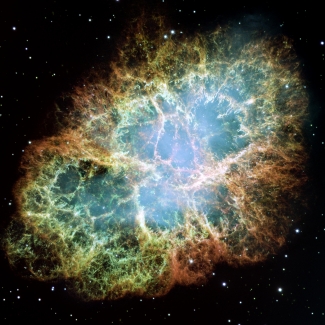On Earth, people use enormous linear accelerators and synchrotrons for such purposes as high-energy physics experiments, chemical composition analysis, and drug research. Linear accelerators ramp up the speeds of electrons and other charged subatomic particles close to the speed of light. Synchrotrons also accelerate charged particles (in a circular track) that, when deflected through magnetic fields, create extremely bright high-energy light.
Both of these processes occur naturally inside the Crab Nebula. Throughout the nebula, linear acceleration processes boost electrons to very high energies. In one tiny area of the nebula, however, synchrotron processes also generate intense and focused beams of gamma rays. These beams are produced from particularly energetic electrons (traveling near the speed of light) that are also gyrating in a magnetic field. As the most energetic gyrating electrons calm down, they emit gamma rays with highest energies produced anywhere in space by a synchrotron process.
The Crab Nebula’s day-long gamma-ray flares were discovered by the space telescope AGILE in 2007 and confirmed by the Fermi telescope in 2010. By August of 2011, Fellow Mitch Begelman and his CU colleagues Dmitri Uzdensky and Benoît Cerutti had figured out how the flares were produced in the celestial linear accelerator. They were also able to explain why the flares had higher energies than expected.
In the energetic and chaotic environment of the Crab Nebula, multiple powerful linear accelerators ramp up the speed of electrons traveling along them — to close to the speed of light. These linear accelerators are produced by the annihilation of reversing magnetic fields, creating ideal conditions for producing synchrotron radiation. The magnetic fields lurch and twist throughout the center of the nebula, buffeted by winds produced by the pulsating neutron star (pulsar) at the center of the Crab Nebula. Inside the roiling environment of the nebula, the magnetic lines of force bump up against each other with their directions out of alignment.
When this happens, the reversing magnetic fields get weaker, allowing the accompanying electric field to get stronger. These rapid changes cause electrons funneled into this region to get even more energetic. And, as the electrons get more energetic, they are driven into a place where the magnetic field is quite small. There they can be accelerated to higher energies than was once thought possible. Eventually, the ultrahigh energy electrons calm down by releasing a powerful, but narrow, beam of gamma rays in just one direction.
Begelman and his colleagues believe that such gamma-ray flares are emitted continually from the central part of the Crab Nebula. However, we Earthlings can only “see” the ones that just happen to be aimed right at us or toward a space-based telescope.
Their new insights into the genesis of these gamma-ray flares from the Crab Nebula are helping Begelman and his colleagues to better understand similar space phenomena such as the high-energy jets produced by pulsar winds, gigantic black holes in the center of galaxies, or extremely energetic quasars known as blazars. The researchers are currently exploring the evolution of idealized simulations of these astrophysical phenomena.




